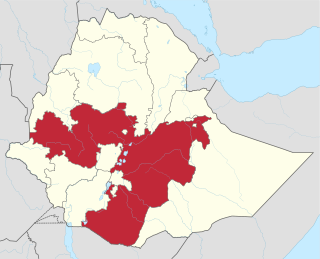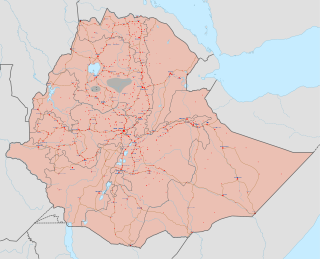Erer | |
|---|---|
| Country | |
Erer is a zone of Somali Region in Ethiopia. [1] [2]
Erer | |
|---|---|
| Country | |
Erer is a zone of Somali Region in Ethiopia. [1] [2]

Somalia is a country located in the Horn of Africa which officially consists of the intra-46th meridian east territory, the seven federal member states, namely Galmudug, Hirshabelle, Jubaland, South West, Puntland, and the municipality of Benadir. It is bordered by Ethiopia to the west, the Gulf of Aden to the north, the Somali Sea and Guardafui Channel to the east, and Kenya to the southwest. With a land area of 637,657 square kilometers, Somalia's terrain consists mainly of plateaus, plains and highlands. Its coastline is more than 3,333 kilometers in length, the longest of mainland Africa. It has been described as being roughly shaped "like a tilted number seven".

Oromia is a regional state in Ethiopia and the homeland of the Oromo people. The capital of Oromia is Addis Ababa, also called Finfinne.

The Somali Region, also known as Soomaali Galbeed and officially the Somali Regional State, is a regional state in eastern Ethiopia. Its territory is the largest after Oromia Region. The regional state borders the Ethiopian regions of Afar and Oromia and the chartered city Dire Dawa to the west, as well as Djibouti to the north, Somalia to the northeast, east and south; and Kenya to the southwest.

Sitti Zone, formerly known as Shinile, is a zone in Somali Region of Ethiopia.

Fafan is a zone in Somali Region of Ethiopia. It was previously known as the Jijiga zone, so named after its largest city, Jijiga. Other towns and cities in this zone include Awbare, Derwernache, Kebri Beyah, Harshin, Goljano, Tuli Gulled and Hart Sheik. Fafan is bordered on the south by Jarar, on the southwest by Nogob, on the west by the Oromia Region, on the north by Sitti, and on the east by Somaliland.
Dollo is one of the nine zones in the Somali Region of Ethiopia. It was previously known as Warder/Werder, so named after its largest city, Warder. Dollo is bordered on the southwest by Korahe, on the northwest by Jarar, and on the southeast by Somalia. The Provisional Administrative Line defines the southeast border with Somalia.
Dembel is a woreda in Somali Region, Ethiopia. Part of the Shinile Zone, Dembel is bordered on the west by Shinile, on the north by Ayesha, and on the east and south by the Jijiga Zone. Towns in Dembel include Arabi, Dembel, Samakab, Sandalol, Biobahie, Dure and Harmukale.
Awbare, officially known as Teferi Ber, is one of the woredas of the Fafan Zone in the Somali Region of Ethiopia. Awbare is bordered on the southwest by Jijiga, on the west by the Sitti Zone, on the east by Somaliland, and on the southeast by Kebri Beyah. Cities and towns in the Awbare district include Awbare, Awbube, Sheder, Lefe Isa, Derwernache, Gogti, Jaare and Heregel.
Kebri Beyah is a city and woreda in Somali Region, Ethiopia. Part of the Kebri Beyah is bordered on the south by the Degehabur Zone, on the southwest by the Fiq Zone, on the northwest by Gursum, on the north by Jijiga and Awbare, on the northeast by Somaliland, and on the east by Harshin. The City administrative center is Kebri Beyah City.
Aware is one of the woredas (districts) of Ethiopia in the Somali Region. Part of the Jarar Zone, formerly Degehabur Zone, Aware is bordered on the south by Gunagadow, on the west by Degehabur, on the north by the Jijiga Zone, on the northeast by Somaliland, and on the east by Misraq Gashamo. Gunagadow, Daroor, Yoocaale, and Gashamo woredas were all separated from Aware between 1995 and 2015. The capital of the woreda is Aware.

The Insurgency in Ogaden was an armed conflict that took place from 1994 to 2018. It was fought by separatists, the Ogaden National Liberation Front (ONLF), against the Ethiopian government. The war began in 1994, when the ONLF tried to separate Ethiopia's Somali Region from Ethiopia. It ended in a peace agreement as part of Prime Minister Abiy Ahmed's reforms.

The Somali civil war (2009–present) is the ongoing phase of the Somali civil war which is concentrated in southern and central Somalia. It began in late January 2009 with the present conflict mainly between the forces of the Federal Government of Somalia assisted by African Union peacekeeping troops and al-Qaeda-aligned al-Shabaab militants.
Hargelle is a district of Somali Region in Ethiopia.
Gunagado is a district of Somali Region in Ethiopia.
Birqod or Bir-qod is a district of Somali Region in Ethiopia.

Daawa is a zone in Somali Region of Ethiopia.. Daawa is bordered on the south by Kenya, on the northwest by the Oromia Region, on the northeast by Liban. Towns in Daawa zone include Mubarak, Mooyale, Hudhet, Kedaduma and Lahey.
The Afar–Somali clashes are territorial conflicts between the Afar and Somali Regions of Ethiopia. The current conflict which began in 2014, is centered around three special Kebeles inhabited by ethnic Somalis from the Issa Clan. These three special Kebeles include the Adaytu in Mille woreda, Undufo in Gewane woreda, and Gedamaytu in Amibara Woreda.

Following the 2018 dissolution of the ethnic federalist, dominant party political coalition, the Ethiopian People's Revolutionary Democratic Front, there was an increase in tensions within the country, with newly resurgent regional and ethnically based factions carrying out armed attacks on military and civilians in multiple conflicts throughout Ethiopia.
The 1995 Ethiopian Federal Constitution formalizes an ethnic federalism law aimed at undermining long-standing ethnic imperial rule, reducing ethnic tensions, promoting regional autonomy, and upholding unqualified rights to self-determination and secession in a state with more than 80 different ethnic groups. But the constitution is divisive, both among Ethiopian nationalists who believe it undermines centralized authority and fuels interethnic conflict, and among ethnic federalists who fear that the development of its vague components could lead to authoritarian centralization or even the maintenance of minority ethnic hegemony. Parliamentary elections since 1995 have taken place every five years since enactment. All but one of these have resulted in government by members of the Ethiopian People's Revolutionary Democratic Front (EPRDF) political coalition, under three prime ministers. The EPRDF was under the effective control of the Tigray People's Liberation Front (TPLF), which represents a small ethnic minority. In 2019 the EPRDF, under Abiy, was dissolved and he inaugurated the pan-ethnic Prosperity Party which won the 2021 Ethiopian Election, returning him as prime minister. But both political entities were different kinds of responses to the ongoing tension between constitutional ethnic federalism and the Ethiopian state's authority. Over the same period, and all administrations, a range of major conflicts with ethnic roots have occurred or continued, and the press and availability of information have been controlled. There has also been dramatic economic growth and liberalization, which has itself been attributed to, and used to justify, authoritarian state policy.